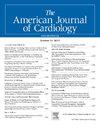Distal Radial Artery Approach for Invasive Blood Pressure Monitoring in Intensive Cardiac Care Unit
IF 2.3
3区 医学
Q2 CARDIAC & CARDIOVASCULAR SYSTEMS
引用次数: 0
Abstract
Distal radial artery (dRA) is a novel vascular access site in interventional cardiology. We evaluated the use of dRA as alternative approach to standard forearm radial artery (fRA) for invasive blood pressure monitoring in Intensive Cardiac Care Unit (ICCU). This is a single-center, randomized, noninferiority trial. Patients admitted in ICCU needing invasive blood pressure monitoring were randomly allocated to dRA or fRA access site (1:1 ratio). Primary endpoint was noninferiority of dRA in the final catheterization success rate. Secondary endpoints were: first attempt success rates; arterial catheterization time; catheterization-related quality of pain; incidence of complications. A total of 250 patients were enrolled (125 in each arm). Final success rate was 95.2% in the dRA group versus 96.8% in the fRA arm (p <0.001 for noninferiority). First attempt success rates were 59.2% with dRA and 70.4% with fRA (p = 0.12). There was no difference in arterial catheterization time and catheterization-related quality of pain between the 2 arms. Entry-site complications were reduced with dRA (6.7% vs 17.4% in the fRA group; p = 0.013); this was mainly driven by decreased incidence of hematoma (0.8% vs 6.6%; p = 0.020). A numerically lower occurrence of arterial occlusion was observed with dRA (0.8% vs 4.9%; p = 0.06). In conclusion, in ICCU patients, the use of dRA to invasively monitor blood pressure is noninferior to fRA for catheterization success rates and may reduce entry-site bleeding.
桡动脉远端入路在心脏重症监护病房有创血压监测中的应用
桡动脉远端是介入心脏病学中一种新的血管通路。我们评估了dRA作为标准前臂桡动脉(fRA)在心脏重症监护病房(ICCU)有创血压监测中的替代方法。这是一项单中心、随机、非劣效性试验。icu收治需要有创血压监测的患者按1:1的比例随机分配到dRA或fRA接入点。主要终点为dRA对最终置管成功率的非劣效性。次要终点是:第一次尝试成功率;动脉置管时间;导尿相关疼痛质量;并发症的发生率。共纳入250例患者(每组125例)。dRA组的最终成功率为95.2%,而fRA组为96.8%(非劣效性p <;0.001)。dRA组首次尝试成功率为59.2%,fRA组为70.4% (p = 0.12)。两组在动脉置管时间和置管相关疼痛质量上均无差异。dRA组降低了入口部位并发症(6.7% vs . fRA组17.4%;P = 0.013);这主要是由于血肿发生率降低(0.8% vs 6.6%;P = 0.020)。dRA组动脉闭塞发生率较低(0.8% vs 4.9%;P = 0.06)。综上所述,在重症监护室患者中,使用dRA有创性监测血压在置管成功率方面不低于fRA,并可减少进入部位出血。
本文章由计算机程序翻译,如有差异,请以英文原文为准。
求助全文
约1分钟内获得全文
求助全文
来源期刊

American Journal of Cardiology
医学-心血管系统
CiteScore
4.00
自引率
3.60%
发文量
698
审稿时长
33 days
期刊介绍:
Published 24 times a year, The American Journal of Cardiology® is an independent journal designed for cardiovascular disease specialists and internists with a subspecialty in cardiology throughout the world. AJC is an independent, scientific, peer-reviewed journal of original articles that focus on the practical, clinical approach to the diagnosis and treatment of cardiovascular disease. AJC has one of the fastest acceptance to publication times in Cardiology. Features report on systemic hypertension, methodology, drugs, pacing, arrhythmia, preventive cardiology, congestive heart failure, valvular heart disease, congenital heart disease, and cardiomyopathy. Also included are editorials, readers'' comments, and symposia.
 求助内容:
求助内容: 应助结果提醒方式:
应助结果提醒方式:


